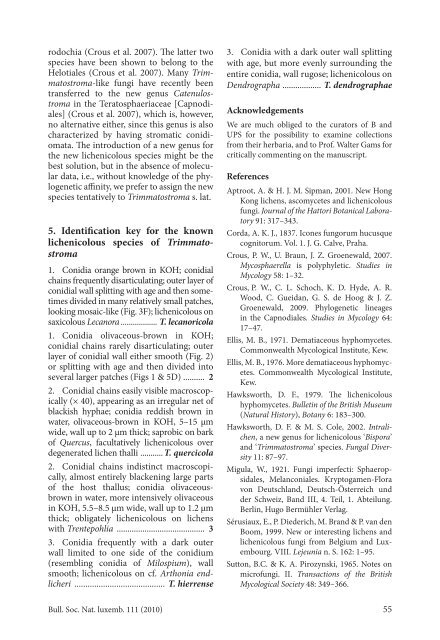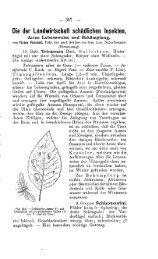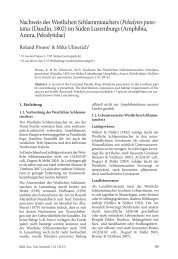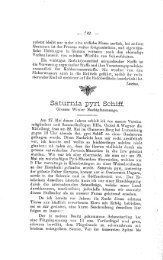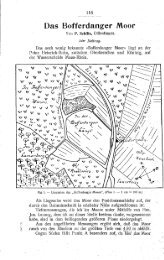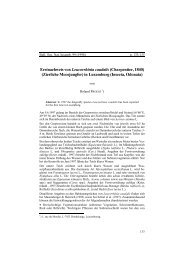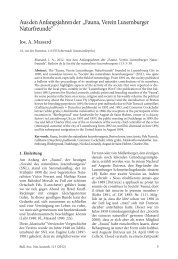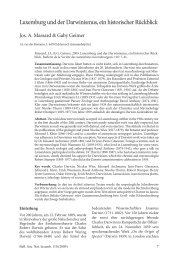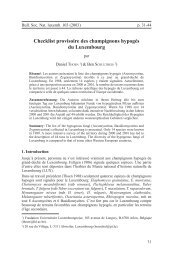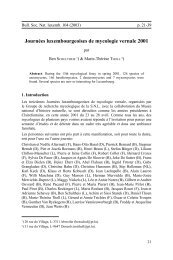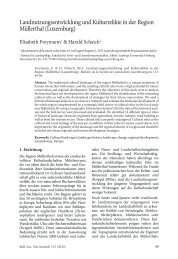Four new lichen-associated Trimmatostromaspecies ... - SNL
Four new lichen-associated Trimmatostromaspecies ... - SNL
Four new lichen-associated Trimmatostromaspecies ... - SNL
Create successful ePaper yourself
Turn your PDF publications into a flip-book with our unique Google optimized e-Paper software.
odochia (Crous et al. 2007). The latter two<br />
species have been shown to belong to the<br />
Helotiales (Crous et al. 2007). Many Trimmatostroma-like<br />
fungi have recently been<br />
transferred to the <strong>new</strong> genus Catenulostroma<br />
in the Teratosphaeriaceae [Capnodiales]<br />
(Crous et al. 2007), which is, however,<br />
no alternative either, since this genus is also<br />
characterized by having stromatic conidiomata.<br />
The introduction of a <strong>new</strong> genus for<br />
the <strong>new</strong> <strong>lichen</strong>icolous species might be the<br />
best solution, but in the absence of molecular<br />
data, i.e., without knowledge of the phylogenetic<br />
affinity, we prefer to assign the <strong>new</strong><br />
species tentatively to Trimmatostroma s. lat.<br />
5. Identification key for the known<br />
<strong>lichen</strong>icolous species of Trimmatostroma<br />
1. Conidia orange brown in KOH; conidial<br />
chains frequently disarticulating; outer layer of<br />
conidial wall splitting with age and then sometimes<br />
divided in many relatively small patches,<br />
looking mosaic-like (Fig. 3F); <strong>lichen</strong>icolous on<br />
saxicolous Lecanora................... T. lecanoricola<br />
1. Conidia olivaceous-brown in KOH;<br />
conidial chains rarely disarticulating; outer<br />
layer of conidial wall either smooth (Fig. 2)<br />
or splitting with age and then divided into<br />
several larger patches (Figs 1 & 5D) .......... 2<br />
2. Conidial chains easily visible macroscopically<br />
(× 40), appearing as an irregular net of<br />
blackish hyphae; conidia reddish brown in<br />
water, olivaceous-brown in KOH, 5–15 µm<br />
wide, wall up to 2 μm thick; saprobic on bark<br />
of Quercus, facultatively <strong>lichen</strong>icolous over<br />
degenerated <strong>lichen</strong> thalli ........... T. quercicola<br />
2. Conidial chains indistinct macroscopically,<br />
almost entirely blackening large parts<br />
of the host thallus; conidia olivaceousbrown<br />
in water, more intensively olivaceous<br />
in KOH, 5.5–8.5 µm wide, wall up to 1.2 μm<br />
thick; obligately <strong>lichen</strong>icolous on <strong>lichen</strong>s<br />
with Trentepohlia .......................................... 3<br />
3. Conidia frequently with a dark outer<br />
wall limited to one side of the conidium<br />
(resembling conidia of Milospium), wall<br />
smooth; <strong>lichen</strong>icolous on cf. Arthonia endlicheri<br />
.......................................... T. hierrense<br />
3. Conidia with a dark outer wall splitting<br />
with age, but more evenly surrounding the<br />
entire conidia, wall rugose; <strong>lichen</strong>icolous on<br />
Dendrographa .................. T. dendrographae<br />
Acknowledgements<br />
We are much obliged to the curators of B and<br />
UPS for the possibility to examine collections<br />
from their herbaria, and to Prof. Walter Gams for<br />
critically commenting on the manuscript.<br />
References<br />
Aptroot, A. & H. J. M. Sipman, 2001. New Hong<br />
Kong <strong>lichen</strong>s, ascomycetes and <strong>lichen</strong>icolous<br />
fungi. Journal of the Hattori Botanical Laboratory<br />
91: 317–343.<br />
Corda, A. K. J., 1837. Icones fungorum hucusque<br />
cognitorum. Vol. 1. J. G. Calve, Praha.<br />
Crous, P. W., U. Braun, J. Z. Groe<strong>new</strong>ald, 2007.<br />
Mycosphaerella is polyphyletic. Studies in<br />
Mycology 58: 1–32.<br />
Crous, P. W., C. L. Schoch, K. D. Hyde, A. R.<br />
Wood, C. Gueidan, G. S. de Hoog & J. Z.<br />
Groe<strong>new</strong>ald, 2009. Phylogenetic lineages<br />
in the Capnodiales. Studies in Mycology 64:<br />
17–47.<br />
Ellis, M. B., 1971. Dematiaceous hyphomycetes.<br />
Commonwealth Mycological Institute, Kew.<br />
Ellis, M. B., 1976. More dematiaceous hyphomycetes.<br />
Commonwealth Mycological Institute,<br />
Kew.<br />
Hawksworth, D. F., 1979. The <strong>lichen</strong>icolous<br />
hyphomycetes. Bulletin of the British Museum<br />
(Natural History), Botany 6: 183–300.<br />
Hawksworth, D. F. & M. S. Cole, 2002. Intra<strong>lichen</strong>,<br />
a <strong>new</strong> genus for <strong>lichen</strong>icolous ‘Bispora’<br />
and ‘Trimmatostroma’ species. Fungal Diversity<br />
11: 87–97.<br />
Migula, W., 1921. Fungi imperfecti: Sphaeropsidales,<br />
Melanconiales. Kryptogamen-Flora<br />
von Deutschland, Deutsch-Österreich und<br />
der Schweiz, Band III, 4. Teil, 1. Abteilung.<br />
Berlin, Hugo Bermühler Verlag.<br />
Sérusiaux, E., P. Diederich, M. Brand & P. van den<br />
Boom, 1999. New or interesting <strong>lichen</strong>s and<br />
<strong>lichen</strong>icolous fungi from Belgium and Luxembourg.<br />
VIII. Lejeunia n. S. 162: 1–95.<br />
Sutton, B.C. & K. A. Pirozynski, 1965. Notes on<br />
microfungi. II. Transactions of the British<br />
Mycological Society 48: 349–366.<br />
Bull. Soc. Nat. luxemb. 111 (2010) 55


